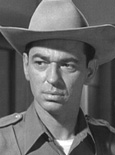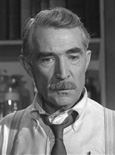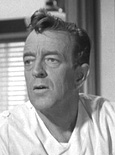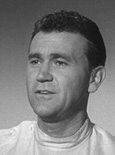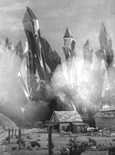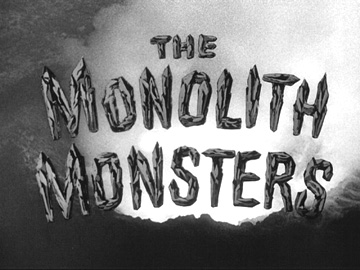 Ah,
the 1950’s. The golden age of the modern nuclear family. With
the post WWII economy booming, things were looking bright for America.
Destiny had never been so clear. Alas, there are always things that
stood in the way of that shining glory. The atomic age ushered in an
entirely new spectrum of national fears and among them was the insidious
Red Menace posed by the Soviets and the fear of runaway science, frighteningly
brought to reality by the destruction of Hiroshima and Nagasaki at the
close of the Second World War. Added into the mix was the wide spread,
but less prevalent fear of death from outer space, most usually imagined
in the form of some violent alien species hell bent on wiping out mankind
before he could get around to inventing the really good things like
the internet and ipods. All manner of unearthly threats were brought
to cinematic life for the entertainment of the masses. Amorphous blobs,
giant robots, funky green men, invisible invaders and even…rocks.
Yes, you read that right, rocks. How could rocks from outer space threaten
mankind? Read on, my friend. Ah,
the 1950’s. The golden age of the modern nuclear family. With
the post WWII economy booming, things were looking bright for America.
Destiny had never been so clear. Alas, there are always things that
stood in the way of that shining glory. The atomic age ushered in an
entirely new spectrum of national fears and among them was the insidious
Red Menace posed by the Soviets and the fear of runaway science, frighteningly
brought to reality by the destruction of Hiroshima and Nagasaki at the
close of the Second World War. Added into the mix was the wide spread,
but less prevalent fear of death from outer space, most usually imagined
in the form of some violent alien species hell bent on wiping out mankind
before he could get around to inventing the really good things like
the internet and ipods. All manner of unearthly threats were brought
to cinematic life for the entertainment of the masses. Amorphous blobs,
giant robots, funky green men, invisible invaders and even…rocks.
Yes, you read that right, rocks. How could rocks from outer space threaten
mankind? Read on, my friend.
After
a brief science lesson about meteors – narrated by the recognizable
voice of Paul Frees - and some cheap FX, we see a meteorite coming crashing
to Earth, creating a large fiery crater. This is the cue for the opening
credits and music to assault our senses, the bombastic melody enough
to blow your eardrums if not careful.
We
see Ben Gilbert, who works for the Department of the Interior in the
local district office located in the small town of San Angelo. Ben is
driving through the desert when he has to stop his overheating vehicle
and refill the radiator. Littered on the ground in all directions are
small dark rocks, near obsidian in appearance. Finished with his task,
he collects one of the strange rocks and continues back to town.
He
arrives in San Angelo, which seems to skirt the desert and farmland
of southern California. As he is cruising through town, I realize I
have seen that town square before. Why it’s Hill Valley from the
Back to the Future films! I almost expect Biff Tannen to come
roaring around the corner in his car. Alas, this is just the Universal
studios back lot, utilized in filming countless movies and television
shows, including both this film and the trio of Marty McFly films.
Ben
parks his car and heads for his office. Martin Cochrane, the editor
of the local newspaper, stops by for a visit after locking up his own
office a few doors away. Ben shows him his newly discovered rock and
admits that he doesn’t know what it is. A cursory examination
proves it to be quite unusual in composition. Martin bemoans the fact
that there is nothing to write about in the small community. Ben says
that maybe he can write an article about the new rock. As you can see,
this town is about as exciting as a flea circus.
Later
that night, the wind has picked up quite a bit. It seems Ben sleeps
at the office (either that or he got booted from his normal digs) and
has left the windows open, allowing a strong breeze to knock over a
clipboard, which in turn breaks a beaker and douses the new rock with
water. Hearing the racket, Ben awakes and closes the windows before
heading back to bed. But, wait! There’s something wrong with the
new rock. It’s reacting to the water that was spilled on it. Ben
walks closer and…the music swells and the film fades out. I can
only assume that something unpleasant happened.
 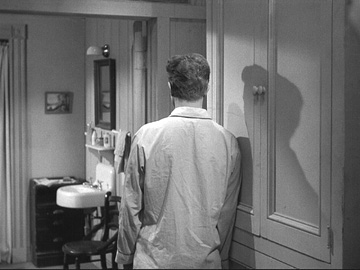 The
next day, Ben’s partner at the district office, Dave Miller, returns
from a trip to Bakersfield. Surprised to see Ben’s car parked
outside but the office locked, he enters to find the back workroom a
total mess. There are strange black rocks everywhere and poor Ben is
as still as a statue and standing propped up against the wall. In fact,
he is a statue, having been petrified in some fashion. Needless
to say, he is very, very dead. The
next day, Ben’s partner at the district office, Dave Miller, returns
from a trip to Bakersfield. Surprised to see Ben’s car parked
outside but the office locked, he enters to find the back workroom a
total mess. There are strange black rocks everywhere and poor Ben is
as still as a statue and standing propped up against the wall. In fact,
he is a statue, having been petrified in some fashion. Needless
to say, he is very, very dead.
Out
in the desert we now see Cathy Barrett, a local school teacher that
has brought her students here to…you know, I’m not sure
why she brought them out here. To learn about the desert? How to get
stung by a scorpion and fall on a cactus while spasming in pain? Maybe
she intends on conveniently “losing” a few of the more troubled
students while she’s out there. For whatever reason, the school
she teaches at must be extremely poor, as she has ferried the kids in
her own car rather than a school bus. The students run around crazy
as kids will do, except for young Ginny Simpson, who finds one of the
dark black rocks that are scattered all over the hillside. After their
excursion to the desert, Cathy returns Ginny home where the last thing
the girl does is drop her new “souvenir” into a tub of water
before running inside for dinner.
Later
at Doctor Reynolds’ place, Dave, Cathy, Martin and Police Chief
Dan Corey await the autopsy report on stone cold (literally!) Ben Gilbert.
Reynolds emerges and says that he has to send the stiff (ha!) away for
someone else to examine, as he can’t explain what happened to
Ben. It seems his entire body – organs, skin, and muscle tissue
– has been welded into a single mass. There are just no clues
to what befell him. Dave brings up the condition of the lab and the
multitude of black rocks, producing a sample from his pocket. Martin
says that when he left Ben, there was only one such rock. Cathy chimes
in and says that her student, Ginny, had picked up a similar rock when
in the desert and took it home with her. Dave suggests checking up on
her, just in case there is a correlation between the strange black rocks
and Ben’s demise.
Dave,
Cathy and Chief Corey pile into Dave’s car and head out to the
Simpson farm. There they discover the house reduced to a pile of lumber
amidst a massive amount of black rocks. Ginny is found alive but in
shock, unresponsive to Cathy’s words. It’s too late for
the girl’s parents however, who are found in the same condition
as Ben was: hard as stone. Chief Corey stays behind while Dave and Cathy
take Ginny to the Doctor’s place and summon additional help.
Dave
further examines the rock, but is confused by its structure and composition.
It seems the rock, aside from a trace of iron phosphate, is comprised
solely of silicates: chert, feldspar, flint, etc. He has no idea how
a single piece can multiply like they’ve seen. Meanwhile, young
Ginny has taken a turn for the worse. It seems her hand has turned to
stone and the effect is spreading. She needs to be taken to Los Angeles
to see a specialist named Doctor Steve Hendricks. Dave volunteers to
take the girl and naturally, Cathy, who has developed an almost unhealthy
fixation with the young girl, accompanies him.
In
Los Angeles, things get even worse for Ginny. The infection spreads,
paralyzing muscles and requiring her to be placed in an iron lung in
order for her to breath. Doctor Hendricks is just as puzzled as Reynolds
was, having no clue as to what is happening to Ginny. All anyone knows
is that those strange black rocks are connected in some fashion. Dave
decides to call upon his old college professor, Arthur Flanders, in
the morning, in hopes that he can be of help. Knowing how bad Ginny
is, Hendricks urges Dave to go immediately and get Flanders out of bed
if necessary.
Like
everyone else, Flanders is puzzled by the rock’s composition.
He theorizes that it’s a meteorite and that is why no one has
encountered it before. The professor wants to return to San Angelo to
examine the accident sites as well as look for a possible point of impact.
They had better hurry, cuz Ginny only has about eight hours to live.
Cathy opts to stay behind to watch over the child.
At
the Simpson farm, Flanders notices something that couldn’t be
seen previously because it was too dark. It seems the ground is discolored
where the strange rocks are touching it. The affected soil is lifeless.
Back at the District office, Dave and Flanders explain to Chief Corey
and Doc Reynolds that the silica content of the soil, as well as that
of the building materials in the Simpson place, is missing. Flanders
thinks that the multiplication process has a side effect: the absorption
of silica from anything the rocks come into contact with, be it wood,
soil or people. This might explain why folks have been turning to stone.
This information is relayed to Los Angeles where Ginny is being treated
while Dave and Flanders going searching for the original meteorite.
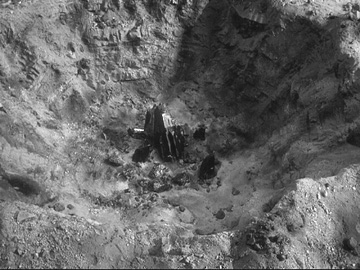 They
follow the old San Angelo road up into the mountains and come across
the place where the rocks are scattered all over. They search closer
and locate the crater housing the parent meteorite. Meanwhile in Los
Angeles, Doctor Hendricks is injecting Ginny with Silica (no smart ass
remarks about her being too young for breast implants), hoping to artificially
replenish in her body what the meteor rock had taken. They
follow the old San Angelo road up into the mountains and come across
the place where the rocks are scattered all over. They search closer
and locate the crater housing the parent meteorite. Meanwhile in Los
Angeles, Doctor Hendricks is injecting Ginny with Silica (no smart ass
remarks about her being too young for breast implants), hoping to artificially
replenish in her body what the meteor rock had taken.
Returning
to San Angelo, we see that night has fallen and the wind has once again
picked up. In the district office of the Department of the Interior,
Dave and Professor Flanders work at unlocking the secrets of the meteor
rock, trying various methods to get the rock to grow. Nothing seems
to work. As they ponder the mystery, the sound of rain and thunder is
heard outside, heralding the approach of a storm. Eventually, by sheer
accident, a sliver of rock in the sink is exposed to water when Dave
pours out a pot of coffee and begins to grow. Testing and confirming
the results, they conclude that as long as there is water, the rocks
will continue to grow.
Cue
the thunder. Dave sees the rain through the window and in a collective
“oh, shit” moment, the two men put two and two together
and race back up into the mountains to check on the meteor. They don’t
make it all the way, however, as the road is blocked by towering monoliths
of rock, reaching hundreds of feet into the sky. When they grow too
unsteady, the massive rocks collapse and shatter, the smaller pieces
beginning the growing process all over again.
Pardon me a moment while I ask the obvious question: how in the hell
can water (which is nothing more than oxygen and hydrogen) cause a rock
to grow? It would seem to me that there is not enough energy within
the water to result in such an accelerated increase in mass and volume.
Then again, I’m no scientist. What do I know?
Dave
realizes that the monoliths will follow the natural canyon slope and
plow right through town. He tries to convince Chief Corey to evacuate
San Angelo before the monoliths arrive. Calling the weather bureau,
they determine that the rains will end in a few hours, long before the
rocks reach town. With two days before additional precipitation arrives,
that gives them a small window of opportunity to devise a way of stopping
the rocks.
At
the hospital in Los Angeles, Ginny wakes from her catatonic state. It
seems the silica injection worked and she will all right…well,
until she remembers that her parents are dead. Cathy tries to call Dave
with the good news, but can’t get a line through to San Angelo
because the town has lost power. Doctor Hendricks has the California
Highway Patrol dispatch a car to the town to locate Dave.
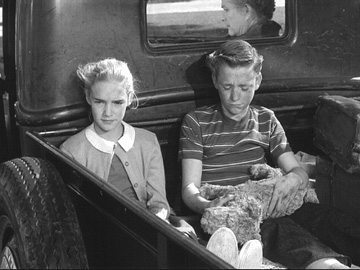 The
ChiPs guys arrive, find Dave and using their radio, he is able to communicate
with Doctor Hendricks. Relived to hear that Ginny is going to be okay,
Dave thinks the same solution used on her to arrest the infection could
also be used to control the rocks’ growth. Hendricks agrees and
relays the components he used. As they’re talking, a local named
Joe Higgins, who lives on the outskirts of town, comes rolling up in
his truck, bewildered and in shock. Before he can explain anything,
Chief Corey knows what he is going to say: giant towers of rock destroyed
his farm and killed his livestock. As an example, Higgins shows them
the family dog, still being cradled by his two kids. However, the poor
pooch is as hard as granite and looks like he’d make a better
door stop than family pet. A scream pierces the air. It seems Mrs. Higgins
has the same affliction that Ginny had. Her hand has turned to stone. The
ChiPs guys arrive, find Dave and using their radio, he is able to communicate
with Doctor Hendricks. Relived to hear that Ginny is going to be okay,
Dave thinks the same solution used on her to arrest the infection could
also be used to control the rocks’ growth. Hendricks agrees and
relays the components he used. As they’re talking, a local named
Joe Higgins, who lives on the outskirts of town, comes rolling up in
his truck, bewildered and in shock. Before he can explain anything,
Chief Corey knows what he is going to say: giant towers of rock destroyed
his farm and killed his livestock. As an example, Higgins shows them
the family dog, still being cradled by his two kids. However, the poor
pooch is as hard as granite and looks like he’d make a better
door stop than family pet. A scream pierces the air. It seems Mrs. Higgins
has the same affliction that Ginny had. Her hand has turned to stone.
Doctor
Reynolds communicates with Doctor Hendricks, making plans for the latter
to bring a portable iron lung for Mrs. Higgins. Meanwhile, Mr. Higgins
informs Dave that the monoliths are still growing, even without rain.
It was them that smashed the power line that runs into town, explaining
San Angelo’s lack of power. With only six and half miles between
the monoliths and town, Dave rushes out to check on their progress.
Flanders returns to the lab to work on a way to stop them with Hendricks'
formula, while Chief Corey and Martin devise a way to warn the people
of town that the time has come to flee. Using a hand-cranked press,
Martin produces a flyer that is distributed by an army of kids on bikes.
Checking
on the progress of the monoliths, Dave sees that the soil is still quite
saturated with water, allowing the rocks continued growth. He times
the cycle of each growth and collapse, determining that they only have
seven or eight hours until the rocks come crashing through town. Flanders
has had no success in using Hendricks' formula to stop the growth of
the rocks. Things are looking rather grim and property values in town
are probably plummeting faster than Enron’s stock.
Note
- It is at this point that the movie enters its final segment, so if
any of you really feel the need to watch this film and not know the
ending ahead of time, skip the rest of this section.
After
numerous more failed attempts, they realize it wasn’t the components
of Hendrick’s formula that did the trick, but the saline solution
he used to hold them all together. Meanwhile, Cathy has returned, accompanying
Hendricks who is just in time to save Mrs. Higgins with his iron lung.
Brainstorming
ideas for stopping the monoliths before they destroy town, Dave feels
they need to be halted just as they emerge from the canyon and before
they can spread across open ground. However, his idea for covering a
swath of terrain with salt from the nearby salt flats is too time consuming.
Consulting
the map again, Dave comes up with a new idea that can be summed up thusly:
Blow Shit Up. His idea is to detonate charges at a local dam, releasing
reservoir water that will then follow the wash down the valley. Passing
over the salt flats, it will absorb enough to stop the Monoliths when
they exit the canyon. The crucial element will be timing; blowing the
dam at the right instant so the water will hit the monoliths at the
proper moment.
The
problem is, the dam is privately owned and with the governor unreachable,
Dave would be exceeding his authority in deciding to destroy the dam.
Still, with little time remaining and no other option, Dave can’t
wait for the Governor to give the go ahead. He races off to locate and
plant the dynamite with a small army of helpers from the salt mine.
Once everything is in place he heads back to San Angelo. The monoliths
continue their inexorable march toward town. With still no word from
the Governor, who is on his way to survey the disaster area, the time
arrives to detonate the dynamite. Dave gives the word and KABOOM goes
the stock footage.
The
reservoir water comes pouring down the wash, soaking up salt from the
salt mine (now obliterated…and yes the workers there were warned
to flee) and the salt flats. The salty flood crashes into the monoliths
and within seconds their advance is brought to a halt. Now nothing more
than big useless chunks of rock, they collapse for the final time.
With
the monolith threat ended, word finally comes from the Governor, who
says to not blow up the dam…unless it is absolutely certain to
be successful. Everyone breathes a huge sigh of relief, especially Dave,
whose ass is now officially off the line.
 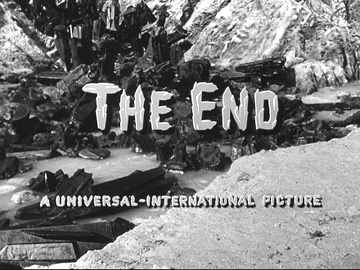 The
End The
End
Review
The
story here unfolds according to the standard 1950’s sci-fi template.
There are strange deaths that lead to a mystery to be solved. Once the
threat is realized, attempts are made to neutralize it, but fail. When
things are looking the gloomiest, an eleventh hour solution is thrown
together that just barely saves the day. All in all, basic stuff for
the era, but this is a movie that is more than just the sum of its parts.
After
all manner on otherworldly threats, it’s nice to see something
different. I’m sure most people had never thought about giant
rocks from outer space as a threat. At least not ones that don’t
just hurtle out of the sky and squish you flat. The idea behind the
monolith monsters can be somewhat frightening. There is no living, breathing
or thinking organism to combat, just lifeless rocks and chemical reactions
as your foe. They are more a force of nature than a rampaging threat
on the loose. As such they might not be quite as scary or as terrifying
as some drooling beast about to gobble you up, but they still make for
an unnerving threat.
Aside
from all the rocks, the humans populating the film fare pretty well.
While this film is no deep examination of Humanity, you can still expect
the characters to behave realistically, making decisions and reacting
to their circumstances like one would expect a real person to do. This
lends a little bit more credibility to the outlandish tale. Killer rocks
from outer space? It sounds goofy, but if these people are damn well
taking it seriously, why not the audience? The actors really help sell
this, giving it their all. There are lots of small “character”
moments that really let these people come to life, allowing the audience
to cheer on their efforts.
Produced
by Universal, the film is competently made with both cheesy and well
done FX. The miniatures used to showcase the monoliths as they crash
into buildings is not very convincing, whereas some of the composite
shots showing the people in town and the monoliths in the distance,
look very good. Sure, there are goofs here and there, but a 50’s
science fiction or horror film without one is a very rare thing indeed.
Check this
one out.
|





